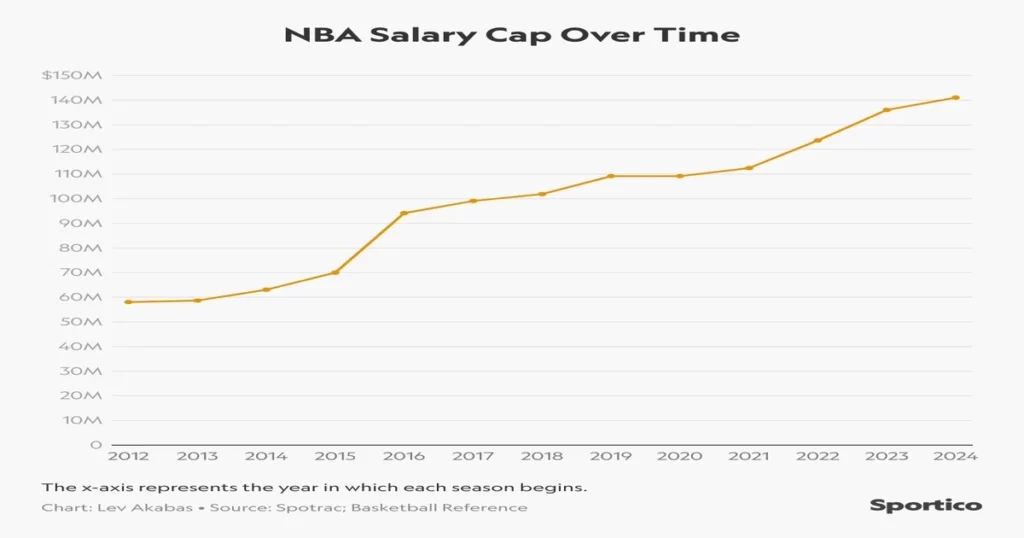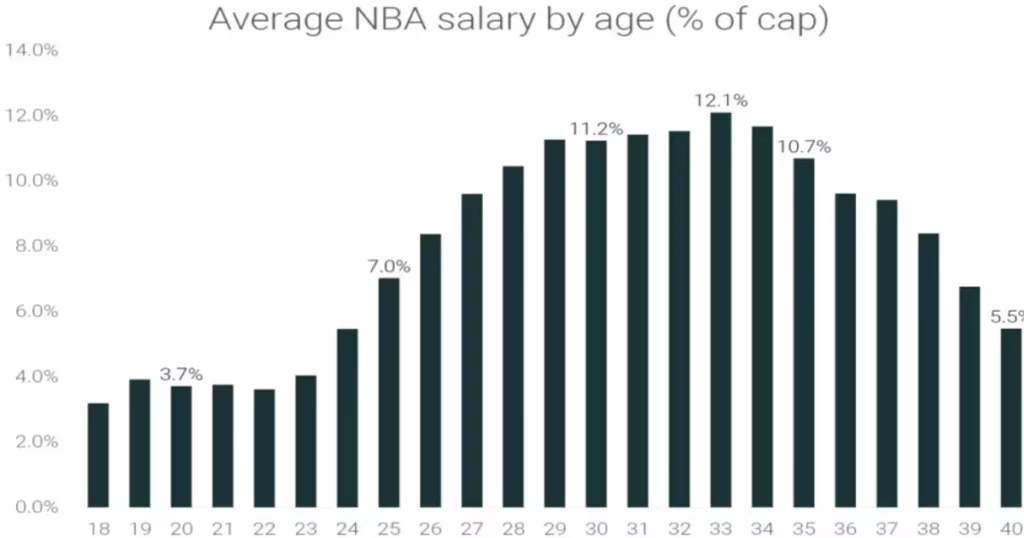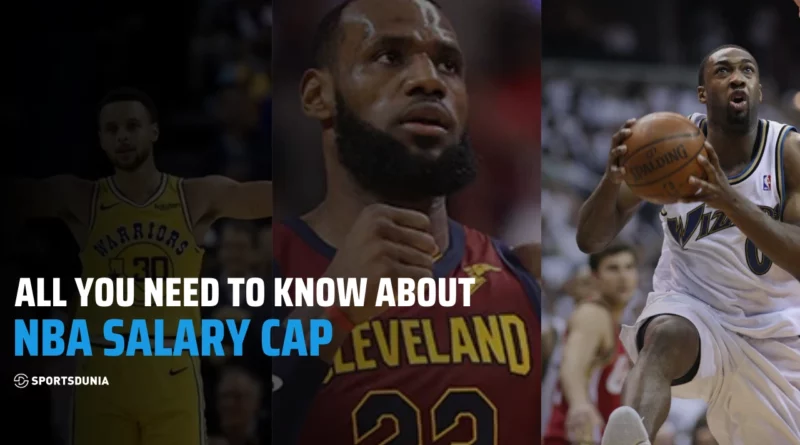NBA Salary Cap: Structure, Trade Impacts, and Tax Explained
The NBA salary cap sounds like more of a technical term to basketball enthusiasts and other sports lovers. However, when this term enters the NBA, it comes with a variety of other terms like the “non-taxpayer mid-level exception” and “veteran player extension.” Even terms like first apron and second apron come into play while the sport that we are discussing here is basketball. Well, we have got you covered on this one to explain to you all the technical nuances of how far teams and player can go with their signing amounts.
What is the NBA Salary Cap?
The NBA salary cap was a type of system that was put together in place to maintain fair play among the team in terms of spending on the players. Such restrictions curbed the practice of acquiring the big names of the league with huge bank balances so that the smaller teams don’t get affected. Notably, the salary cap also affects the trades, squad formation, and free agency of the teams and players.
Technically, the NBA salary cap is a restriction on the spending power of the teams in a season. This restriction is decided each year by projecting how much the league is going to earn in the upcoming season and then a certain percentage of this income is derived as the salary cap amount by league officials. According to Reuters, the salary cap for the 2024-25 NBA season is $140.588 million.
The concept of the salary cap was first introduced to the NBA league in the 1984-85 season so that teams could not accumulate all the talent of the league. The NBA has a “soft” salary cap and can accept going over this cap under certain circumstances, also known as exceptions in the Collective Bargaining Agreement(CBA). In the 2024-25 season, according to Spotrac, all of the league’s 30 teams spent more than the cap on player salaries.
However, the salary cap also makes sure that the players are not underpaid. That’s why the franchises have to spend at least 90% of the salary cap on the players. This way, unlike MLB, which has large differences in spending levels among different teams, the NBA maintains consistency in that sense.
Also Read: How Many Fouls to Foul Out in the NBA: Rules and Regulations Explained
How Does NBA Salary Cap Work?

The salary cap is decided according to the NBA’s Basketball Related Income (BRI). It includes revenue from ticket sales, broadcasting rights, sponsorships, and merchandising. Later on, the NBA and the players’ union negotiated the percentage of BRI allocated to salaries. Later on, a pre-decided percentage of the BRI is allotted to player salaries, and this figure is divided by the number of teams to get the salary cap for the upcoming season.
The luxury tax threshold for the 2024-25 season is $170.814 million. If the teams surpass this threshold, then they would have to pay a luxury tax. The amount of this tax increases exponentially depending upon how much teams are spending over the luxury tax limit. Through this rule in the books, teams cannot escape from the consequences of overspending in the league.
We have explained the exceptions through which the franchises in the NBA can get past the salary cap:
Mid-Level Exception (MLE):
The mid-level exception (MLE) is a tool that can be used by each team once a year to sign one or more players. Notably, they can use this system even if their payroll goes beyond the salary cap. In the upcoming season, the franchises can offer first-year salaries of up to $5.2 million in deals lasting up to two years using the “Taxpayer MLE”. However, the franchises using the “Non-Taxpayer MLE” can offer first-year salaries of up to the limit of $12.8 million in deals for a period of up to four years.
Those amounts on a yearly basis according to the changes in the salary cap. However, these privileges are not available to the teams that are above the second apron. They can’t use MLE to sign free agents, and teams that use it are hard-capped at the second apron.
Bird Rights:
A team can surpass the salary cap to re-sign its own free agents at an amount up to the maximum salary according to “Bird Exception.” However, there is a condition for the player to exercise this rule. He must have played for the franchise for three years continuously to get the benefit from “Bird rights.” This rule is titled as “named as “Bird Rights” because the Boston Celtics were the first team allowed to exceed the salary cap to re-sign one of their own players.
There is another rule that goes by the name “early Bird exception.” This provision enables a team to re-sign its free agents if they played for the team for some or all of the previous two seasons. Through this rule, teams can offer more than 105% of the average player’s salary for the prior season or a 175% surge on the player’s last salary. Also, a team can still re-sign its own free agent who neither has Bird nor early Bird rights. But it carries more restrictions on the player’s salary, unlike the Bird Rights.
Rookie Scale Contracts
Rookie contracts for NBA first-round draft picks are related to the salary cap. Such contracts change based on the players’ draft position. That’s why the value of the contracts drops for the lower picks in the first round. The first two years of such deals are guaranteed, and years three and four are team options. However, a major chunk of picks in each draft class go with the team options.
The franchise must offer at least 80% of the “rookie scale contract,” and it should not be more than 120%. Practically, almost every deal is completed at a maximum of 120% in current times. The NBA allows teams to sign their draft picks to rookie scale contracts even if they are over the salary cap. The second round picks for the salary minimum but they don’t have any definite restriction on salary allocation.
Bi-Annual Exception
Teams cannot use the bi-annual exception if they’ve already exercised the MLE. Also, the franchises that use the bi-annual exception are hard-capped at the first apron. It is a tool that can be used by each team in non-consecutive seasons to sign one or more players despite its payroll already exceeding the salary cap. During the ongoing season, teams can offer first-year salaries of up to $4.7 million in deals lasting up to two years.
Team-by-Team Analysis of NBA Salary Cap Space for 2024-25
The salary cap of the franchise sometimes also reveals the plans or moves they might make in the upcoming seasons. Therefore, we have tabulated the cap hit and cap space of the teams in the NBA according to Spotrac data. This data includes all 30 teams namely Detroit Pistons, Utah Jazz, Miami Heat, Oklahoma City Thunder, Chicago Bulls, Indiana Pacers, Minnesota Timberwolves, Sacramento Kings, Orlando Magic, Phoenix Suns, and more.
| Rank | Team | Total Cap Hit | Cap Space |
|---|---|---|---|
| 1 | Detroit Pistons | $141.8M | $-1.2M |
| 2 | Orlando Magic | $150.3M | $-9.7M |
| 3 | Utah Jazz | $153.6M | $-13.0M |
| 4 | San Antonio Spurs | $161.7M | $-21.1M |
| 5 | Oklahoma City Thunder | $165.0M | $-24.4M |
| 6 | Charlotte Hornets | $167.1M | $-26.5M |
| 7 | Memphis Grizzlies | $167.3M | $-26.7M |
| 8 | Chicago Bulls | $168.0M | $-27.4M |
| 9 | Philadelphia 76ers | $169.7M | $-29.2M |
| 10 | Indiana Pacers | $170.4M | $-29.8M |
| 11 | Houston Rockets | $171.9M | $-31.3M |
| 12 | Sacramento Kings | $172.2M | $-31.6M |
| 13 | Los Angeles Clippers | $173.6M | $-33.0M |
| 14 | Atlanta Hawks | $173.8M | $-33.2M |
| 15 | Portland Trail Blazers | $176.8M | $-36.2M |
| 16 | Toronto Raptors | $177.3M | $-36.7M |
| 17 | Cleveland Cavaliers | $178.0M | $-37.5M |
| 18 | Miami Heat | $179.3M | $-38.7M |
| 19 | Brooklyn Nets | $182.3M | $-41.7M |
| 20 | New Orleans Pelicans | $182.5M | $-41.9M |
| 21 | Dallas Mavericks | $188.0M | $-47.5M |
| 22 | New York Knicks | $188.3M | $-47.8M |
| 23 | Denver Nuggets | $192.7M | $-52.1M |
| 24 | Milwaukee Bucks | $195.2M | $-54.6M |
| 25 | Golden State Warriors | $198.6M | $-58.0M |
| 26 | Boston Celtics | $199.3M | $-58.7M |
| 27 | Los Angeles Lakers | $200.5M | $-59.9M |
| 28 | Washington Wizards | $209.8M | $-69.2M |
| 29 | Phoenix Suns | $228.4M | $-87.8M |
| 30 | Minnesota Timberwolves | $236.6M | $-96.0M |
What is Luxury Tax in the NBA?
After crossing the limit of the NBA salary cap, if a team goes beyond the luxury tax threshold, they have to pay an additional monetary tax, which is known as the Luxury Tax. Such tax heavily burdens the teams financially and ensures that they don’t keep on overspending. The farther the team goes with the overspending after the luxury tax limit, the greater they get fined for the rule breach. For example, a franchise like the Golden State Warriors or the Los Angeles Lakers that exceeds the limit by $10 million could pay a 1.5x tax, meaning they would owe $15 million in luxury taxes.
How Much Can Teams Pay Individual Players?

Usually, the time that the NBA players have spent in the league, along with the salary cap in a particular season, affects the amount of salary that a player receives in the league. However, the maximum salary that an NBA player can receive can be explained under the following heads:
- 0-6 years of experience: If a player holds the mentioned level of experience, his maximum contract will comprise 25% of the salary cap
- 7-9 years of experience: As the experience increases up to 9 years, the player can receive 30% of the salary cap under the maximum contract
- 10+ years of experience: The league veterans with greater potential to offer can get 35% of the salary cap after more than ten years of experience in the league.
For example, in the 2024-25 season, which has a salary cap of $140.588 million, the maximum salaries the players can receive can be mentioned as follows:
- 0-6 years: $35.147 million
- 7-9 years: $42.176 million
- 10+ years: $49.206 million
These numbers also change if the players make the transition in the Collective Bargaining Agreements. Such modifications happen if the league undergoes a big transformation or signs a large amount in the marketing industry. Currently, NBA athletes like LeBron James, Stephen Curry, and Nikola Jokić are among those who hold the top salaries in the NBA.
How Does the Salary Cap Impact Trades and Free Agency?
The salary cap does affect the way the teams make trades in the league or sign players during the free agency period. It includes a variety of rules or exceptions through which the NBA franchises carve their path to make a flexible roster that does not go far beyond the salary cap. Here is a breakdown of the impact that salary cap has on the free agency and trades of a franchise.
Impact on Trades:
- Salary Matching: If the teams make a trade in the NBA league, then the franchises must match a certain percentage of salaries as the player has a definite contract with the previous team
- Trade Exceptions: If the teams make a trade and get a lesser salary from the opposite team, they can sign more players without fear of going over the salary cap.
- Sign-and-Trades: A franchise signs a player as a free agent and then quickly trades it to the other teams in the league. This way, if a team has restrictions regarding the salary cap, then they can get a high-salary player without bearing the financial burden.
Impact on Free Agency:
- Max Contracts: If a big star player is a free agent, he usually goes for a max contract, considering his level of skills and experience in the NBA.
- Mid-Level Exception (MLE): The mid-level exceptions give the privilege to acquire position-specific players to support the big names.
- Buyouts and Waivers: Sometimes, franchises release the players or even waive them to manage the salary cap chart in the league.
The NBA Salary cap is a chart of financial rules and regulations that keeps the franchise in check. Such rules help the teams to build the squads with a greater potential to get to the title. Eventually, it also maintains a competitive impartiality in the league so that the franchises don’t go too far with their spending abilities. It leads to an environment where fans can witness the fair competition among the franchises in the NBA.
Also Read: How Do NBA Playoffs Work: Rules and Format Explained
What is the current NBA salary cap?
The NBA’s salary cap for the 2024–2025 season is $140.588 million per team.
When did the NBA salary cap start?
The NBA salary cap was first implemented during the 1984-85 season.
What is the maximum salary for the NBA?
A player in the first year of a supermax contract earns 35% of the salary cap, and the salary cap is expected to increase in the league by 10% every year. So, the maximum salary for the NBA can vary as the cap amount increases every season.
Why can NBA teams go over the salary cap?
NBA teams can go over the salary cap because the league operates with a “soft cap,” meaning there are exceptions and loopholes that allow them to exceed the cap limit, primarily by utilizing “Bird Rights” to re-sign their free agents at a higher salary, while incurring a “luxury tax” penalty for every dollar spent above the cap limit.
What is the difference between soft and hard caps?
In the NBA, a “soft cap” means teams can exceed the salary cap under certain circumstances using exceptions, while a “hard cap” strictly prohibits any team from going above the set salary limit, essentially meaning teams cannot spend more than the cap under any situation; the NBA has a soft cap, while leagues like the NHL have a hard cap.
What happens if a team exceeds the salary cap?
If an NBA team exceeds the salary cap, they are required to pay a “luxury tax” on every dollar they spend over the cap limit. With rising expenses, the tax amount also increased exponentially based on how far over the cap they are. In addition, if a team goes significantly over the cap, they may face further restrictions on roster building, including limitations on signing free agents and potential draft pick penalties depending on how long they remain over the “second apron” threshold.
When does the NBA announce the new salary cap?
The NBA announced the salary cap for the 2024–2025 season on June 30, 2024. The new salary cap went into effect on July 1, 2024.
